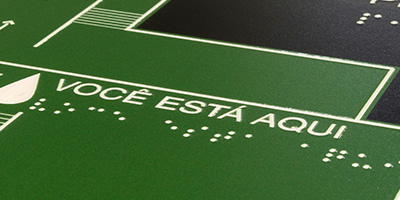A braille signage option from S3F Signs




Identification signs and orientation


Orientation plans



Tactile signaling

Advisory partner
This team has the advisory partner of ACAPO (Association of the Blind and partially sighted of Portugal), an entity to which we submit all Braille signs and support equipment (tactile floors) produced by our company, for verification and subsequent approval.
Braille Systems
Pitons
This product consists of studs made of high quality stainless steel or plastic. Studs are applied to floors in order to create tactile surfaces to guide the blind or partially sighted. They are designed in a single piece to guarantee long-term stable performance. Its top is non-slip in order to offer greater resistance to slipping.
Product available in stainless steel with various finishes and in plastic. in standard colors of yellow and red.



LOGES touch language codes

Straight Track Code
The straight walk is guaranteed by grooves oriented in the direction of march and separated according to precise norms, related to the characteristics of the plantar tactile sense and to ensure that the end of the white cane is used as a guide and that it does not leave the trail.

STOP / Danger code
It is a symbol adopted internationally and of instinctive understanding: the spherical relief that makes it up is immediately felt under the feet, causing a distinct sensation of discomfort.

Overcome Hazard Code
It consists of the combination of the attention and danger codes. It is applied close to areas that require precaution (eg, a zone and stairs or a crosswalk). Differentiation in relation to the Stop / Danger code, ignored by other systems is essential to ensure the correct understanding of the situation and, therefore, the safety of the blind.

Attention / Service Code
A thin corrugated surface perpendicular to the grooves of the straight path warns the blind person of the need to pay attention or of the lateral presence of a service (eg presence of a door, an elevator, a tactile map or a ticket office, etc,).
This groove produces an extraordinary effect of vibration in the hand that holds the white cane that follows the grooves.

Intersecting Union
A square plate with small embossed discs warns the blind person of the presence of an intersection in which they can choose between two or three possible directions.

Mandatory Turning Union
It is a square that serves to join two sections of straight path applied at 90 degrees. The curved grooves coincide with the straight ones, while on the outside of the curve, the spherical reliefs do not allow the advance in the wrong direction.
Information
The abolition of architectural barriers is now foreseen in the legislation of all democratic countries. It is worth noting the acceptance of the concept that architectural barriers also include precetive barriers, which prevent or hinder the autonomous mobility of the blind.
The full right of blind people to take advantage of these actions has recently been reinforced by the UN Convention on the Rights of Persons with Disabilities, ratified by Italy with the law of 25 February 2009, as well as by 80 other countries around the world.
The CEN 12199 standard concerns the technical characteristics of the materials and not the tactile paths.
In addition, there is a European standard, CEN / TS 15209, which currently provides only 2 codes, stop and go, and not the 4 second level standards, indispensable for building tactile paths that can be fully used by those who do not see and that also exist in the Loges system
Guideline Guide and Safety
The Loges tactile guidance system was designed by a team of professionals with experience in mobility problems, both for the blind and for people with low vision.
The Loges system was studied and developed and after verifying the problems detected in other tactile path profiles, taking into account the mobility used by the blind during their travels, centered on the use of the tactile, plantar and kinesthetic sense, as well as the use of white cane.
The Loges system
- it has a profile that fully respects the physiology of the step and is perfectly noticeable both inside and outside. In addition, it has been tested by associations of people with motor disabilities who argue that these do not create any problems for them.
- it allows the designer to create a rational and organized path, thanks to which the blind people who are able to move on their own acquire total autonomy during their movements.
- it includes all the necessary and sufficient tactile codes to provide the visually impaired with the information necessary to guarantee a safe and oriented movement, allowing them to also identify the position of the topographic maps in relief.
- it consists of modular elements applicable during the construction of pre-existing floors or pavements.
- it is the only tactile route widely used in Italy since 1996 with tens of thousands of installations, and it is also used in Greece, Portugal and France.
- it is marketed by S3F, and produced in rubber, which makes it totally perceptible by the blind, due to the different acoustic response of this material in relation to the surrounding pavement.
- it is the only one that allows the application of several meters of continuous track, without interruptions, leaks or unevenness, allowing the blind person to slide the tip of the cane in the respective grooves without any obstacle, for a fluid and fast movement.
- it is produced in 4 colors so that the designer can insert it in any environment in the best way, (yellow, red, light gray, dark gray). The possibility of using several colors is fundamental above all to guarantee the luminance contrast necessary to enhance the tactile signal in relation to the surrounding environment, as provided in the law for the protection of people with low vision.
- it can also be installed outdoors with special mixes resistant to UV rays and its application must be completely flat.

